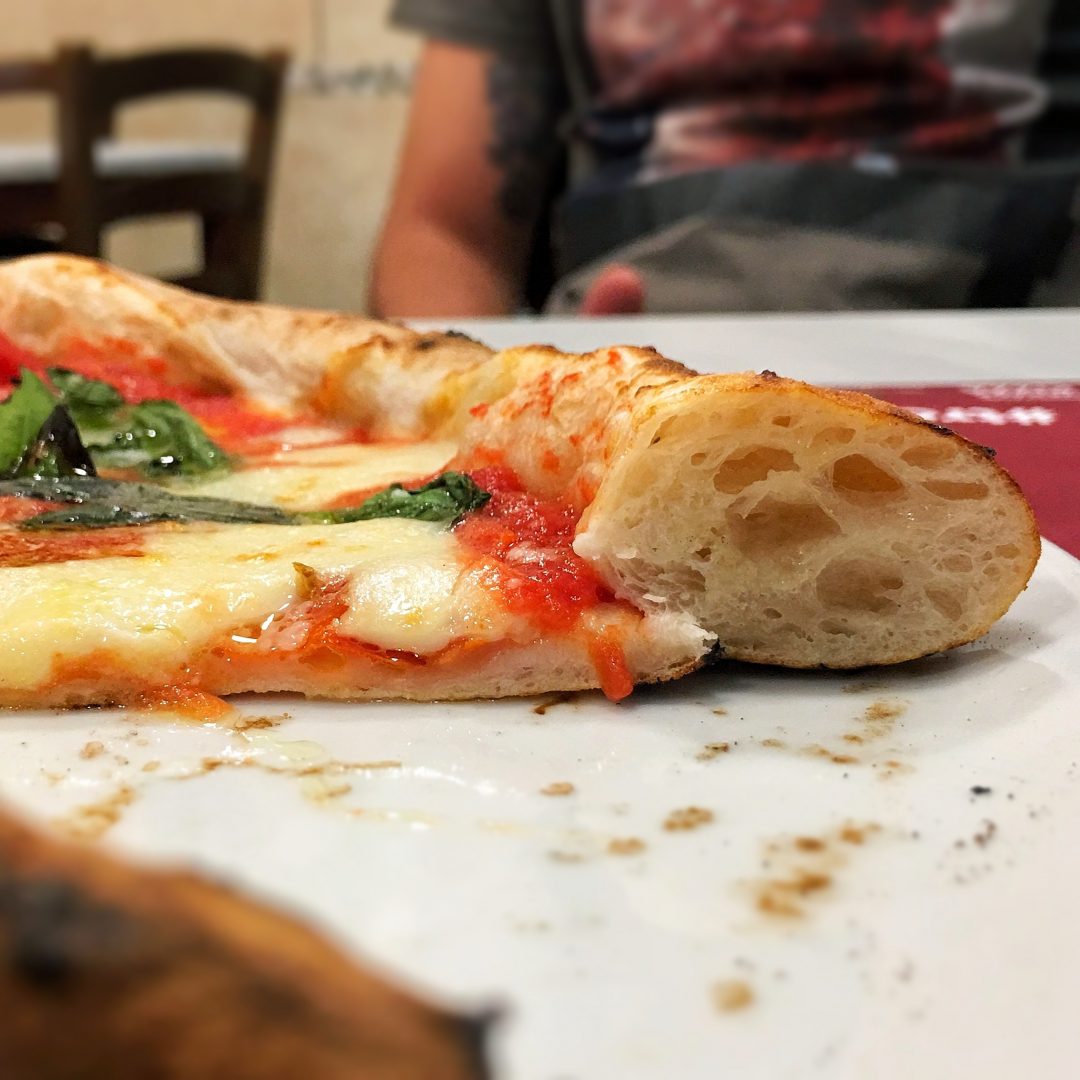Why do we like Pizza? With an eye on the Science
loving Pizza is a state of mind, but the Science also comes in
Column by Francesco Margheriti — 5 years ago

More often, when we finish eating a pizza, we already think of the next time, maybe in the same place, or maybe in other places recommended on websites and guides (or on Garage Pizza! NdTanzen).
Have you ever wondered why, for the majority of populations, even globally, pizza is such a staple meal? Why do we like it so much?
There are several possible answers.
It’s a quick meal: pizza is considered one of the healthiest options when there’s little time for eating. You can find a slice of pizza in any corner of every city, therefore many favour it over the classic junk food.
There are many types: pizza can be appreciated by many people because anyone can favour a different kind of cooking or prepping. This leads to several debates and arguments over the best pizza in town.
There are different flavours: the queen of pizzas is, by definition and tradition, the Margherita pizza. But, over the years, there’s been a number of matchings of ingredients and toppings: this peculiarity makes pizza unique as a base meal that can be used to try different recipes. Anyone can customize it to their own taste, showing off cooking and creative skills at the same time.
It’s always time for a pizza: have you ever had it for breakfast? I, and many others, do it often, as it’s one of those savoury meals that taste better in the morning. Contrary to many other kinds of food of our cuisine, pizza can be consumed for breakfast, lunch, dinner and as a quick break.
It’s easy to prepare: letting aside the final result, which is subjective to the personal taste, a pizza is indeed an easy meal to prepare, due to the few ingredients and the little time needed.
You eat it with your hands (yes, you can): it’s almost mandatory for many people, and eating a pizza with your bare ends is not frowned upon, actually, it makes people want to snatch it from you.
It’s perfect for the lazy ones: you can have it delivered at home, without moving, have it on your couch and, more important, you don’t have to wash any dishes after that.

Hot or cold: it’s usually served piping hot, but it can also be eaten at room temperature, and this won’t affect its organoleptic properties.
It has a captivating shape: most famously the round one. This recalls a round table, which is associated with a sharing moment.
It typically differs in any region: as mentioned before, it’s the most customized meal in the world. It really deserves a tour around Italy, if only to understand and appreciate the differences among the several regions.
It’s a complete meal: to the healthy eaters, to the gourmand, to the fitness addicted, pizza – and especially a good Margherita – is a meal with all the macro and micronutrients we need, like carbohydrates, proteins, lipids, vitamins, and mineral salts.
It makes us like veggies: vegetables can be introduced on a pizza without any issues. For as healthy as they are, usually they’re quite despised by the young or the picky ones. Yet, if they’re on a pizza, there’s no problem with that anymore.
It’s rich in proteins: a Margherita pizza contains an average of 15 grams of proteins for 100 grams of the product. Almost the same amount of chicken.

What’s the Science view on Pizza?
Let’s investigate now pizza from a scientific point of view, my personal favourite as a professional.
People love pizza because probably unaware of it, it’s their body to claim it.
Pizza is rich in antioxidants, chemical compounds contained in several foods, that inhibit the oxidation of other substances and the following formation of free radicals. There’s even a study, conducted on Chicago’s Deep Dish Pizza, which shows that people eating regularly one slice of that pizza every week presents a better clinical picture compared to a non-eater(1). Why? Possibly because the kind of baking leads to the formation of the aforementioned substances and also due to the massive use of tomato sauce.
Tomato sauce which is also essential for the consumption of lycopene, another antioxidant substance also very strong against free radicals, which can be found in all yellow, orange and red fruits and vegetables. Researchers found that, in similar quantities, we absorb more lycopene eating a pizza than a single tomato. This is due to the fact that pizza contains some fats which facilitate the absorption.
Other studies (including Italian research that we’ll discuss in the future) shows that pizza works as “antitumor” or, more precisely, as food that in a Mediterranean diet could prevent the occurrence of cancer (2, 3).
Scientists also wondered why anytime we see a slice of pizza we experience “internal turbulence” all the way up to the taste buds and the salivary glands.
The answer is connected to the substances present in the food, like carbohydrates, fats and proteins, and how they interact with each other and with our organism. Not to forget the mixture of salt and sugar in the dough (4).
All these substances play an essential role in the amygdala, located inside our brain, making us happy.
There was even a study, maybe a bit of an exaggeration, that in 2015 has classified pizza as the first marker to identify individuals tending to addiction, exactly because pizza, with its shape and ingredients, stimulate some area in our brains close to the ones that activate when there’s an addiction. Therefore, as I always say, eat everything you want but with moderation (5).
Pizza is good, everyone likes it and we should eat it. It’s a universal food popular all around the world, customized in every region, still food that’s been with us for centuries… but this is a topic for another article.
La pizza è buona, la pizza piace e va mangiata. La pizza è un alimento universale riconosciuto in tutto il mondo, particolarizzato da luogo a luogo, ma comunque un alimento che, almeno come termine, ci accompagna da centinaia di anni, ma questa storia è per un altro articolo.
- Content of redox-active compounds (ie, antioxidants) in foods consumed in the United States, American Journal of Clinical Nutrition; Bente L Halvorsen, Monica H Carlsen, Katherine M Phillips, Siv K Bøhn, Kari Holte, David R Jacobs Jr; 2006 ↩
- Does pizza protect against cancer?, International Journal of Cancer, Silvano Gallus, Cristina Bosetti, Eva Negri, Renato Talamini, Maurizio Montella, Ettore Conti, Silvia Franceschi, Carlo La Vecchia, 2003 ↩
- Pizza consumption and the risk of breast, ovarian and prostate cancer, European Journal of Cancer Prevention, Gallus, Silvano; Talamini, Renato; Bosetti, Cristina; Negri, Eva; Montella, Maurizio; Franceschi, Silvia; Giacosa, Attilio; La Vecchia, Carlo; 2006 ↩
- Supra-Additive Effects of Combining Fat and Carbohydrate on Food Reward, Cell Metabolism, Alexandra G. DiFeliceantonio, Ge´raldine Coppin, Lionel Rigoux, Sharmili Edwin Thanarajah, Alain Dagher, Marc Tittgemeyer, Dana M. Small, 2018 ↩
- Which Foods May Be Addictive? The Roles of Processing, Fat Content, and Glycemic Load, Plos One, Erica M. Schulte, Nicole M. Avena, Ashley N. Gearhardt, 2015 ↩
